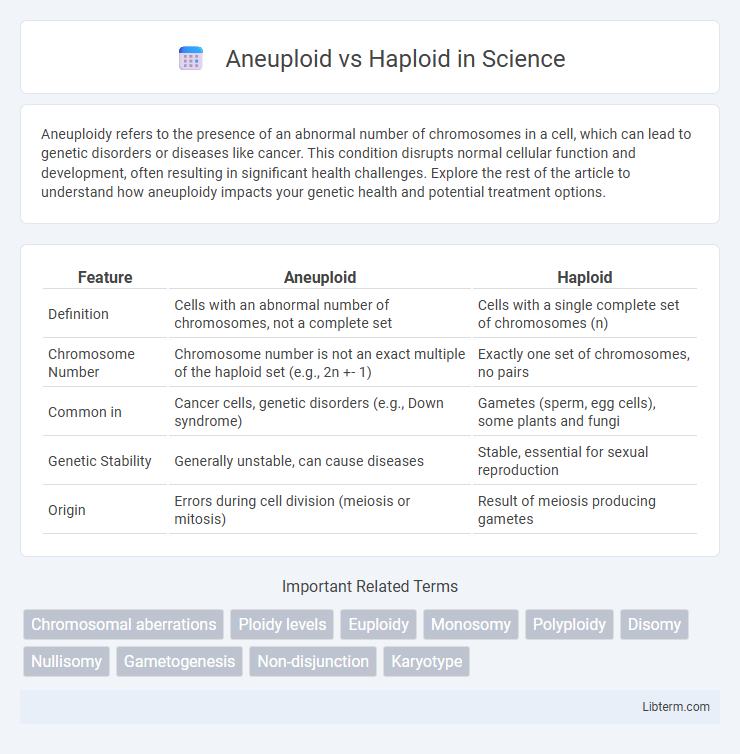Aneuploidy refers to the presence of an abnormal number of chromosomes in a cell, which can lead to genetic disorders or diseases like cancer. This condition disrupts normal cellular function and development, often resulting in significant health challenges. Explore the rest of the article to understand how aneuploidy impacts your genetic health and potential treatment options.
Table of Comparison
| Feature | Aneuploid | Haploid |
|---|---|---|
| Definition | Cells with an abnormal number of chromosomes, not a complete set | Cells with a single complete set of chromosomes (n) |
| Chromosome Number | Chromosome number is not an exact multiple of the haploid set (e.g., 2n +- 1) | Exactly one set of chromosomes, no pairs |
| Common in | Cancer cells, genetic disorders (e.g., Down syndrome) | Gametes (sperm, egg cells), some plants and fungi |
| Genetic Stability | Generally unstable, can cause diseases | Stable, essential for sexual reproduction |
| Origin | Errors during cell division (meiosis or mitosis) | Result of meiosis producing gametes |
Introduction to Aneuploid and Haploid Cells
Aneuploid cells contain an abnormal number of chromosomes, which can lead to genetic disorders or cancer, while haploid cells possess a single set of chromosomes, typical in gametes such as sperm and eggs. Aneuploidy results from errors during cell division, like nondisjunction, causing chromosome number variations important in disease studies. Haploid cells play a crucial role in sexual reproduction by ensuring genetic diversity through meiosis and fertilization processes.
Definition of Aneuploidy
Aneuploidy is a genetic condition characterized by an abnormal number of chromosomes, which deviates from the normal diploid chromosome set. Unlike haploid cells that possess a single complete set of chromosomes (n), aneuploid cells may have extra or missing chromosomes, leading to genetic imbalance. This chromosomal irregularity commonly results in developmental disorders and diseases such as Down syndrome, caused by an extra copy of chromosome 21.
Definition of Haploidy
Haploidy refers to the state of a cell or organism having a single set of unpaired chromosomes, typically denoted as n, which is half the diploid number found in sexually reproducing species. Aneuploidy, in contrast, involves an abnormal chromosome number that is not an exact multiple of the haploid set, resulting from the gain or loss of one or more chromosomes. Haploid cells are essential for sexual reproduction, providing genetic material that combines during fertilization to restore the diploid chromosome number.
Key Differences Between Aneuploid and Haploid
Aneuploid cells contain an abnormal number of chromosomes, typically resulting from nondisjunction events during cell division, leading to either extra or missing chromosomes, whereas haploid cells have exactly one complete set of chromosomes, characteristic of gametes in sexually reproducing organisms. Haploid cells play a crucial role in maintaining genetic stability through sexual reproduction, while aneuploidy often causes developmental disorders or diseases such as Down syndrome, which is caused by trisomy 21. The key difference lies in chromosome count accuracy, with haploid cells maintaining genomic integrity and aneuploid cells exhibiting numerical chromosome abnormalities.
Causes of Aneuploidy in Organisms
Aneuploidy arises from errors in chromosome segregation during cell division, most commonly due to nondisjunction events in meiosis or mitosis, resulting in the presence of an abnormal number of chromosomes. Factors such as spindle assembly checkpoint defects, cohesion loss between sister chromatids, and improper kinetochore-microtubule attachments contribute to these chromosomal imbalances. Unlike haploid cells that contain a single set of chromosomes, aneuploid cells exhibit variations that can lead to developmental disorders and diseases such as Down syndrome and cancer.
Biological Importance of Haploid Cells
Haploid cells contain a single set of chromosomes, essential for sexual reproduction as they ensure genetic diversity through the combination of genes during fertilization. These cells are crucial in gametes such as sperm and eggs, allowing offspring to inherit a balanced chromosome number. In contrast, aneuploid cells have abnormal chromosome numbers, often leading to developmental disorders or diseases like Down syndrome, highlighting the biological importance of maintaining haploidy in reproductive cells.
Genetic Implications of Aneuploidy
Aneuploidy refers to the presence of an abnormal number of chromosomes in a cell, which often results in genetic imbalances that disrupt normal development and cellular function. This chromosomal irregularity can cause severe genetic disorders such as Down syndrome, characterized by an extra copy of chromosome 21, contrasting with haploid cells that contain a single set of chromosomes critical for sexual reproduction. The genetic implications of aneuploidy include altered gene expression, impaired protein synthesis, and increased risk of developmental abnormalities and diseases due to the dosage imbalance of key regulatory genes.
Examples of Aneuploid and Haploid Cells in Nature
Aneuploid cells, characterized by an abnormal number of chromosomes, are commonly found in cancerous human cells where trisomy 21 causes Down syndrome and monosomy X leads to Turner syndrome. Haploid cells, containing a single set of chromosomes, naturally occur in gametes such as sperm and egg cells across most sexually reproducing organisms, including humans and many plants. Some fungi and algae, like the yeast Saccharomyces cerevisiae and the green alga Chlamydomonas reinhardtii, exist predominantly in haploid states during their life cycles.
Medical and Agricultural Relevance
Aneuploid cells, characterized by an abnormal number of chromosomes, are crucial in medical research for understanding genetic disorders such as Down syndrome and various cancers, where chromosomal imbalances disrupt normal cellular functions. Haploid cells, containing a single chromosome set, are essential in agricultural biotechnology for producing genetically uniform crops through haploid breeding techniques, accelerating trait selection and improving yield stability. Both aneuploidy and haploidy serve pivotal roles in advancing genetic studies, disease diagnostics, and crop improvement strategies.
Conclusion: Comparing Aneuploid and Haploid
Aneuploid cells contain an abnormal number of chromosomes, often leading to genetic disorders or cell malfunction, while haploid cells possess exactly one complete set of chromosomes, essential for sexual reproduction. Haploidy ensures genetic stability in gametes, whereas aneuploidy typically results in genomic imbalance and disease. Understanding the differences between aneuploidy and haploidy is crucial for insights into developmental biology and medical genetics.
Aneuploid Infographic

 libterm.com
libterm.com